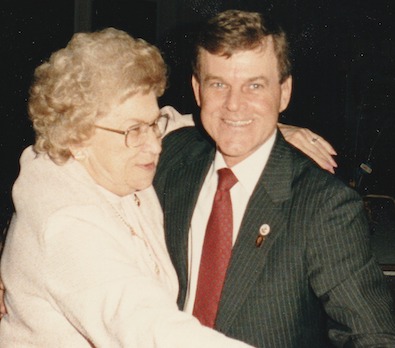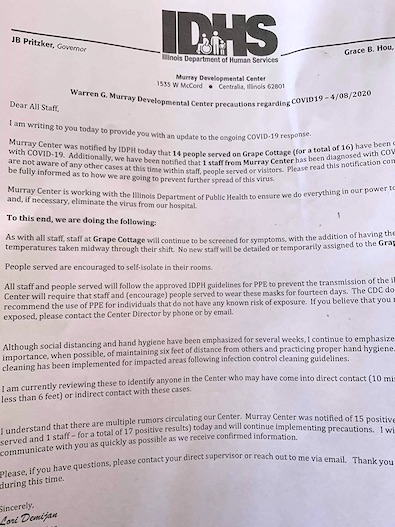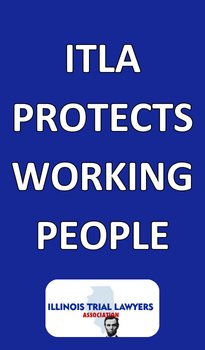* Gov. Pritzker today…
I want to thank Abbott, which informed us yesterday that facilities in our state which are operating with their machines can now access swabs directly from them, instead of through third parties. Great development.
Pritzker noted yesterday that the federal government had “waylaid” the tests and sent them to private entities.
Again, please pardon all transcription typos.
* More from today…
As Dr. Ezike and I told you yesterday, our rate of rise is looking less and less exponential. That indicates to us that we are in fact bending the curve. There is even some evidence that we may be moving toward a flatter curve. But we need to keep watching the data on a daily basis. Keep in mind our case numbers, and the death toll are still growing. And thus, our fight must continue. And the data will show that those numbers are growing more slowly. And that’s a very good thing.
It’s all of you, the families and individual residents of Illinois, who are making the biggest difference in our fight against COVID-19.
* The governor then went on to highlight and thank groups all over the state which have pitched in during the crisis. Here’s one…
Communities of Southern Illinois came together to launch Marion United, a live stream benefit featuring local artists, musicians and community leaders, sharing hope and encouragement. They raised nearly $200,000 from hundreds of donors money that will go directly to support local businesses that have been impacted.
* The governor started his presser today with a shoutout to this person…
Here’s what he said…
To the Forest Park resident who tweets every day that he has faithfully enjoyed a cocktail or a mocktail during this press conference every afternoon since March, 26: Know that your hashtag, #SpritzersWithPritzker, has brought a smile to the governor’s staff, and lots of people seem to appreciate your tweeting the drink recipes too. So thank you.
* On to questions for the governor and Dr. Ezike. For Dr. Ezike: Why are some zip codes, seeing more cases than others?…
First of all, let’s not put all our eggs in the zip code and the tallies that we have there, because we do know that there are many more positive cases than we have actually tested and confirmed. Again, you know, working as hard as we can to get those testing numbers up and increasing that capacity. But nevertheless, for every case that you find there are many others so it doesn’t mean, again we’ve been stressing that significantly, that even if you think you don’t have a case in your zip code that’s probably not actually the case. But we do know that there are areas, communities, neighborhoods where there’s a higher density of people with, whether it’s comorbidity conditions that predispose to serious complications and death.
* What feedback have you gotten from small business owners about how the minimum wage increase in July?…
You know, it’s only been the, the large business organizations like the Chamber of Commerce who have brought this up. The truth is, the current conditions actually indicate to you more than ever before why we need to raise the minimum wage across the state. So, look where we’re all concerned to make sure that we bring this economy back to where it could be should be after we’re able to get past the peak and past the danger that this poses for many people, but that is very frankly it’s unrelated to the rise in the minimum wage, which is a very small raise you know each year it goes up by a little bit, and it’s a very small raise that’s coming in July relative to, you know, the entire raise which happened over a six year period.
* Governor, the rules of unemployment were supposed to change to allow them to apply for benefits, but we’re hearing from many people that IDES has not yet allowed them access to apply. Is there a timeframe on when this will happen, any advice for these people?…
Well there are federal benefits, you’re right, that were provided in the federal bill, but almost no state has this available to them because you’ve got to build a system for that. That’s not just something you can add on to your existing system. So, we’ve hired the necessary personnel, we’ve hired the outside provider who can build the system for us, and it’ll be up in the coming weeks, coming weeks, kind of the timeline. And again, we’ve got, you know we’ve hired the best we can [who are] working as expeditiously as they can. Every state has this challenge so we’re gonna do it as fast as we possibly can.
* What should we expect for the summer, and could we go through this again come fall or winter?…
Yes. In short, yes. The fact of the matter is that we are not going to be truly able to begin to move on until we have a testing, much greater testing contact tracing and treatment. Test trace and treat. We have to have those available that’s even before there’s a vaccine.
* Governor, your counterpart in New York said this morning that they’re working to ramp up testing sites in the African-American community. You are well aware of Chicago situation. What is being done here in Chicago to get more testing in the African American community?…
We’re doing that very same thing. In fact, I was just talking this morning and yesterday morning about a drive-thru site that we intend to put up in the south suburbs in a heavily African American community. We’re looking at other sites, and the placement of testing sites is directly related to who’s getting tested, of course. So we wanted to make sure that we spread those five minute tests are the five to 15 minute tests the rapid tests into communities where we know we have significant issues like the African American community. So those 15 machines that you heard me talk about yesterday that we’re trying to get more testing capability through. We want to make sure that when those tests come in that many of those are placed in communities where particularly African American communities where people are we have more vulnerability than others.
* Do you think the stay at home order will be lifted before April 30?…
Look, you know, we talk a lot about peaking and we talk a lot about how we’re bending the curve, the curve is still upward trajectory. And so just because we’re bending the curve does not mean it’s bending down yet. And so people need to understand that, that it is unlikely that that we will be able to lift this stay at home before April 30.
* What’s been spent on PPE?…
We’re going to be listing the various contracts online so people can take a look at it. I couldn’t tell you what the total is now, but I know that it’s not infrequent that we have to place a $5 million order, or even a $10 million order for PPE. Think about the cost of what is normally an 85 cent or $1 N95 mask is now going for anywhere between four and $7 apiece. So if you need millions of them as we have indicated that we do a million of those at $5 apiece is $5 million. So that’s just N95 masks.
* Governor Baker of Massachusetts has launched a virtual call center of 1000 people to trace contacts of those testing positive for COVID-19. Are you considering any similar contact tracing measures in Illinois?…
Yep, because it’s a great … indicator of what really needs to happen all across the nation and especially as we … move beyond the peak.
* What is DHS’s plan to mitigate the spread of COVID-19 in residential centers for the developmentally disabled now that cases are reported, especially given the challenges that population presents, including, not necessarily understanding what’s going on?…
Dr. Ezike: So we believe that, you know, we’re going to be able to limit the spread. As you know as best we can with PPE, with the staff following the protocols and by separating the various residents between those who have COVID- 19 and those who haven’t been. ….Time is becoming relative now, I believe at the end of February beginning of March, they were very proactive. They were immediately following recommendations to start thinking about their facilities trying to identify their space issues trying to figure out how people would be able to be spread out if they needed to isolate and segregate. They, as the governor said, were right on top of it in terms of closing down facilities to visitors I know sometimes people would think that sounds difficult but in a situation such as this where you know that the virus is being brought in by a visitor. That is the aggressive step that has to be taken also doing pre-shift assessments on people who work in the facility. So, they weren’t even proactively looking at instead of moving people back and forth, they were bringing providers that had to assess people in terms of trying to figure out if there would be need for evaluation if it could be done on site instead of transferring to a hospital. So again, a lot of steps were taken, even before they had a single case, they do have some cases and some other facilities now IDPH is working close with them in terms of having a consultant and infection control preventionist working directly with the facilities. And so, we’re keeping a close eye on and partner I think we had a delivery of PPE with thousands of mass surgical masks and N95, that even went should have been delivered today, so we are following closely and they’re doing a great job and we’re going to mitigate as much as we can.
* There have been reports that HHS plans to no longer support community based COVID-19 sites. Many at Walmart parking lots. Is this accurate has the state been told this will these test sites continue? If so, who will pay for the testing?…
So, just to back up a second, HHS, the federal government, set up this organized effort to have drive thru facilities with Walgreens parking lots, Walmart parking lots, and signed a deal with labcorp and quest which are two of the largest laboratories in the nation to do the actual evaluation of the test the swabs themselves would be done at the drive thru. And then those swabs are sent to labcorp and quest. That’s what we’re talking about when we talk about the federal sites that HHS put up. We have a number of those sites in Illinois.
It is true that on April 10, which I think is tomorrow, they will be handing over those sites to the States. Their intention, they didn’t say this upfront but it became clear about a week ago, that their intention was to set these up to make them operational and then to hand them over to the States. And so we are taking over those, we will be providing personnel we’ve asked for as much support as we can get from the federal government in that turnover, because obviously we have a limited number of healthcare personnel available in the state, but we need to do this testing. I think the biggest challenge is that they’re only providing a limited number of swabs, for each of those sites as they have only been using a limited number of swabs themselves, and each of those sites and we’d like to do more.
And so I’ve asked for more swabs from the federal government. We’ll see whether we’re able to get them. But our intention is to do as much testing as we possibly can in their drive thru sites but I just want to make it clear that taking a swab is not doing a test taking a swab is taking a specimen, and then putting it in a vial.
* What advice would you give to organizers of big summer events, concerts, etc.? Should they plan to proceed plan on crowd limits, should they think about canceling?…
I think everybody needs to think seriously about canceling large summer events. From my perspective today, I do not see how we are going to have large gatherings of people, again, until we have a vaccine, which is months and months away.
I would not risk having large groups of people getting together, anywhere. And I think that’s hard for everybody to hear but that’s just a fact that they’re just, you know, even with, you know, testing and tracing and treating as is necessary for us to begin to make changes, it isn’t enough for me to say that it’s okay to have a big festival with a whole bunch of people gathering together.
* Have you heard of the workshare program helping 29 states and Washington DC? A University of Illinois professor says Illinois could get $1.1 billion and avert up to 124,000 layoffs will Illinois join?…
Yeah, it’s an excellent program. I understand that the availability of that program was open, under the previous governor and he didn’t act upon it. We are looking at how we might open a program like that at work share program. And I don’t disagree that you know whatever we can get to support workers to expand the workforce or make available opportunities for people who are laid off. We’re going to pursue.
-30-
48 Comments  
|
Ted E. Leverenz
Thursday, Apr 9, 2020 - Posted by Rich Miller
* Ted E. Leverenz was once chairman of the Illinois House’s only appropriations committee. There are now six approp committees.
Ted had amazing sources throughout state government, which he then used to his advantage when pressing agency directors about their shortcomings as administrators. He often jokingly referred to himself as “Agent 99,” a reference to a female spy on the old Get Smart TV show.
Ted was enormously helpful to me when I first started out. He knew so much and he was such an entertaining fellow, particularly when he was relentlessly grilling those aforementioned agency directors. Ted, then-Sen. Judy Baar Topinka and a few others helped a nobody who nobody sent figure out how the government really worked. I will be forever grateful to them.
Ted eventually moved to the Senate via appointment. He was never happy there. He lost all his seniority and complained about how everyone in the chamber was so old. “Their parking places are wider,” he said. “You know why? So they can get their walkers out of their cars!”
* From a Facebook post by his daughter Tracy…
My dad Ted E. Leverenz fought the good fight! Today Jesus carried him home to paradise! April 8, 2020@3:30 pm. Loving husband, father, grandpa and great-grandpa! Heaven is celebrating with joy his homecoming and “Never Had A Bad Day” has a whole new meaning! He was a kind, caring, public servant, who worked tirelessly for the community in numerous ways. He stared in his role as Representative Leverenz then a Senator Leverenz. Politics and helping others were forever running through his veins.
Ted and Rep. Chris Welch never got along well, but when I asked him about Leverenz’s passing today, Welch said, “He never supported me in any election, but there’s a lot of people in my district who revere the guy to this day.”
I think Ted would’ve appreciated that response. /s
* He sure was a handsome devil back in the day…

…Adding… More…
23 Comments  
|
* From the University of Illinois System’s Institute of Government and Public Affairs…
At the request of U of I System President Tim Killeen, IGPA assembled more than four dozen interdisciplinary faculty experts from the three system universities to serve on IGPA’s Task Force on the Impact of the COVID-19 pandemic. […]
This first report, from the Economic and Fiscal Impact Group, draws comparisons to the 2007 to 2009 recession. The authors also used new, national models of the possible economic outcomes from the COVID-19 pandemic to project the potential impact on the three biggest sources of state revenues: individual income tax, corporate income tax and sales tax.
In all but the best-case scenario, the negative impact on state revenue is projected to be worse than during the Great Recession, from 2007 to 2009. Under the most severe model of a protracted downturn followed by a weak recovery after a severe pandemic, Illinois could lose more than $28 billion between calendar years 2020 and 2023.
Amanda Kass is a faculty leader on this project, so you know it’s good stuff. The full report is here.
* The chart…

Ain’t nothing good in there.
* Back to the release…
The COVID-19 crisis will also likely harm the finances of all local governments: counties, municipalities, school districts, transit agencies and special districts.
Declines in state revenues, which are shared with local governments, are especially concerning because municipalities in Illinois are more reliant on state revenues than municipalities in most other states.
As state revenues drop, spending on public health and human services is expected to increase. The biggest impact on spending is expected to be a several-billion-dollar increase in Medicaid expenditures.
Market volatility could have a negative impact on pension funds, causing state and local governments to see increases in required annual contributions. But these increases will be somewhat delayed.
“It is too early to precisely quantify the fiscal gap that is likely to be created by reductions in state revenue and increases in the cost of delivering state services, but we believe that it will almost certainly cost billions of dollars and possibly cost tens of billions of dollars,” the report says.
The authors note that the recently approved federal stimulus package will likely fall short in some key ways. For instance, the increase in federal matching funds for Medicaid is much smaller than the enhanced match Congress approved as part of the response to the 2007 recession.
The report emphasizes there will be no easy answers, but suggests that policymakers focus on five basic principles: transparency, protection of the vulnerable, economic efficiency, minimizing borrowing for operating purposes and flexibility.
* In other news…
Oy.
* Meanwhile the Federal Reserve today announced a new $500 billion Municipal Liquidity Facility…
Facility: The Municipal Liquidity Facility, which has been authorized under Section 13(3) of the Federal Reserve Act, will support lending to U.S. states and the District of Columbia, U.S. cities with a population exceeding one million residents, and U.S. counties with a population exceeding two million residents. Under the Facility, a Federal Reserve Bank will commit to lend to a special purpose vehicle on a recourse basis. The SPV will purchase Eligible Notes directly from Eligible Issuers at the time of issuance. The Reserve Bank will be secured by all the assets of the SPV. The Department of the Treasury, using funds appropriated to the Exchange Stabilization Fund under section 4027 of the Coronavirus Aid, Relief, and Economic Security Act, will make an initial equity investment of $35 billion in the SPV in connection with the Facility. The SPV will have the ability to purchase up to $500 billion of Eligible Notes.
Eligible Notes: Eligible Notes are tax anticipation notes (TANs), tax and revenue anticipation notes (TRANs), bond anticipation notes (BANs), and other similar short-term notes issued by Eligible Issuers, provided that such notes mature no later than 24 months from the date of issuance. In each case, a note’s eligibility is subject to review by the Federal Reserve. Relevant legal opinions and disclosures will be required as determined by the Federal Reserve prior to purchase.
Eligible Issuer: An Eligible Issuer is a State, City, or County (or an instrumentality thereof that issues on behalf of the State, City, or County for the purpose of managing its cash flows), in each case subject to review and approval by the Federal Reserve. Only one issuer per State, City, or County is eligible.
Limit per State, City, and County: Limit per State, City, and County: The SPV may purchase Eligible Notes issued by or on behalf of a State, City, or County in one or more issuances of up to an aggregate amount of 20% of the general revenue from own sources and utility revenue of the applicable State, City, or County government for fiscal year 2017. States may request that the SPV purchase Eligible Notes in excess of the applicable limit in order to assist political subdivisions and instrumentalities that are not eligible for the Facility.
Pricing: Pricing will be based on an Eligible Issuer’s rating at the time of purchase with details to be provided later.
Origination Fee: Each Eligible Issuer that participates in the Facility must pay an origination fee equal to 10 basis points of the principal amount of the Eligible Issuer’s notes purchased by the SPV. The origination fee may be paid from the proceeds of the issuance.
…Adding… Press release…
Today, Rep. Raja Krishnamoorthi (IL-08) led congressional delegation letters to House Speaker Nancy Pelosi, House Minority Leader Kevin McCarthy, and U.S. Treasury Secretary Steven Mnuchin calling for immediate aid to state, local, tribal, and territorial governments to address surprise revenue shortfalls.
The letters were joined and signed by each Democratic member of the Illinois congressional delegation: Reps. Bobby Rush, Robin Kelly, Dan Lipinski, Jesus “Chuy” Garcia, Mike Quigley, Sean Casten, Danny Davis, Jan Schakowsky, Brad Schneider, Bill Foster, Lauren Underwood, and Cheri Bustos in addition to Rep. Krishnamoorthi.
“State and local balance sheets across the country are dipping into the red as billions of dollars are being lost from unexpected revenue shortfalls,” said Congressman Raja Krishnamoorthi. “The $150 billion provided to state and local governments in the CARES Act was a good start, but more needs to be allocated for places that are hit hardest by the public health and economic impacts of this crisis. This is an issue that is harming the physical and financial health and safety of state and local governments, their employees, and their constituents, and one that must be addressed in our next COVID-19 legislative package.”
Forcing states and cities to accommodate dramatic budget shortfalls, which are exacerbated in part by lost tax revenues due to halting economic activity, could lead to widespread, disruptive reductions in public services, delayed improvement projects, and a slower economic recovery. Below are some examples of cities and states across the country that are expecting revenue shortfalls:
· New York Governor Andrew Cuomo recently predicted a state revenue shortfall of up to $15 billion.
· Ohio Governor Mike DeWine recently told his cabinet members to prepare for up to 20 percent cuts to agencies for the next 15 months.
· Illinois’ Commission on Government Finance and Accountability recently predicted a potential 20 percent decrease in state revenues over the next few fiscal years.
· Cities across the country, from Phoenix to Houston to Philadelphia, are similarly grappling with difficult budget decisions unforeseen just a few short months ago.
In the letters, the undersigned Members of Congress asked that the “State and Local Coronavirus Expenditures Relief Fund” within the CARES Act be expanded to allow state and local governments to replenish lost revenue as a qualifying expenditure, or that Congress authorize the creation of a new fund to provide direct aid to state and local governments with fewer restrictions. They express that either option must allow greater flexibility in how the funds are spent and include robust funding at a level that will meaningfully alleviate the fiscal problems faced by state, local, tribal, and territorial governments across the country.
13 Comments  
|
* Senate GOP Leader Brady…
Governor Pritzker,
I am writing to you on behalf of my caucus, and the citizens we represent, who have made hundreds of calls to our offices to express their frustration about their inability to access critical unemployment benefits.
Residents throughout Illinois impacted by the economic crisis resulting from the COVID-19 outbreak are struggling to pay their rent and feed their families. During these unprecedented times, we must do everything we can to ensure they are getting the help they need as soon as possible.
One segment of our population impacted by this economic crisis are those self-employed “gig” workers who, according to ADP Research Institute, make up 18 percent of our workforce. Under the recently signed federal stimulus law, these gig workers will now be eligible for unemployment benefits, and states must modify their websites in order to review these claims. This is most welcome news. However, it is our understanding that this modification to the Illinois Department of Employment Security’s (IDES) website could take months.
Weeks ago, our constituents were told the IDES website would be improved, and access would be enhanced. However, based on what we are hearing from our constituents, delays with the site continue and frustrations continue to mount.
With the addition of gig workers, timely access to this site is even more critical, especially given the fact that we are hearing other states already have a system in place to handle gig claims.
When can we tell our constituents they will be able to apply for these crucial resources?
Sincerely,
Bill Brady
Senate Republican Leader
* I asked for a response from the governor’s press secretary, Jordan Abudayyeh…
This administration is committed to lifting up working families during this crisis. IDES is working around the clock to handle the unprecedented volumes of claims and improvements have been made while the office continues to work through the historic number of claims. The CARES Act created a brand new program for workers who have never participated in the unemployment insurance system. The state has contracted with a vendor to get that new program up and running as soon as possible. If lawmakers have ideas on how to improve the process or expand resources for working families even further we’re happy to work with them.
* Related…
* Wanted urgently: People who know a half century-old computer language so states can process unemployment claims
…Adding… From the ILGOP…
This response from Governor Pritzker to criticism for the failures of our unemployment claim system is unacceptable. This is understandably an unprecedented time with major strain on our state agency processing unemployment benefits that help struggling families. First it became clear Illinois is falling behind other states in testing. We can’t afford to fail to provide struggling workers with the help they need to survive. The Governor’s response to reasonable questions amounts to “we are doing the best we can” and if lawmakers have better ideas, “you can do the job.” It is an abdication of leadership to shove responsibility for needed solutions for HIS state agency onto state lawmakers. Leaders lead; they don’t pass the buck when challenged. Governor, do better.
In contrast, here is how a couple Dem Governors are responding differently to the strain:
Cuomo (NY): “I apologize for the pain — it must be infuriating to deal with.”
https://www.nbcnewyork.com/news/local/cuomo-sorry-for-crashing-unemployment-website-deluged-with-3m-hits-in-5-days/2354582/
Newsome (CA): “We all have to do more and to do better.”
https://californiaglobe.com/section-2/california-falls-behind-paying-out-federal-unemployment-dollars/
And NY has found a creative way to deal with the claim load - partnered with Google for a new platform that is rolling out today, moving to a call center, and hiring hundreds of new workers to process claims. https://www.democratandchronicle.com/story/news/politics/albany/2020/04/09/unemployment-claims-ny-frustration-with-filing/2962500001/
29 Comments  
|
* AP…
The Strategic National Stockpile is nearly out of the N95 respirators, surgical masks, face, shields, gowns and other medical supplies desperately needed to protect front-line medical workers treating coronavirus patients.
The Department of Health and Human Services told The Associated Press Wednesday that the federal stockpile was in the process of deploying all remaining personal protective equipment in its inventory.
The HHS statement confirms federal documents released Wednesday by the House Oversight and Reform Committee showing that about 90% of the personal protective equipment in the stockpile has been distributed to state and local governments.
HHS spokeswoman Katie McKeogh said the remaining 10% will be kept in reserve to support federal response efforts. […]
Federal contracting records show HHS made an initial bulk order of N95 masks on March 12, followed by larger orders on March 21. But those contracts won’t yield big deliveries to the national stockpile until the end of April, after the White House has projected the pandemic will reach its peak.
* First, the federal government strictly limited the number of tests at first responder and medical worker drive-through sites to no more than 250 per day. And now this…
Some local officials are disappointed the federal government will end funding for coronavirus testing sites this Friday. In a few places those sites will close as a result. This as criticism continues that not enough testing is available. […]
A spokesperson for the U.S. Department of Health and Human Services tells NPR, “Many of the Community-Based Testing Sites (CBTS) are not closing, but rather transitioning to state-managed sites on or about April 10.”
The agency and a spokesperson for FEMA say the CBTS program originally included 41 sites. It was intended as a stop-gap to bring testing to critical locations, especially for health care facility workers and first responders.
“The transition will ensure each state has the flexibility and autonomy to manage and operate testing sites within the needs of their specific community and to prioritize resources where they are needed the most,” the HHS spokesperson said.
It often feels like we are living through a worst-case scenario.
*** UPDATE *** Press release…
Congressmen Darin LaHood (IL-18) and Rodney Davis (IL-13) today announced that the federal government will extend their funding and support for the McLean County COVID—19 testing facility. Congressman LaHood and Davis released the following joint statement after their visit today at the site.
“Today, we are pleased join federal, state, and local officials in McLean County to announce that the federal government will extend their support and funding for the COVID—19 testing facility at the McLean County Fairgrounds,” said the Congressmen. “The coronavirus pandemic calls on each of us to put aside our political differences and work together to overcome this health and economic crisis. We are pleased that the federal government moved swiftly to expand their support Illinois’ testing ability.
“We also want thank the Adjutant General of the Illinois National Guard, Brig. Gen. Richard Neely, his servicemen and women, and the McLean County Health Department for their tireless work to keep this site running and our community safe. In Congress, we’ll continue to work with our colleagues and the White House in a bipartisan manner to support the McLean County testing site and Illinois’ response.”
15 Comments  
|
6.6 million new jobless claims
Thursday, Apr 9, 2020 - Posted by Rich Miller
* WaPo…
The surge of job losses continued last week with 6.6 million Americans applying for unemployment benefits, the Labor Department said Thursday.
More than 17 million new jobless claims have been filed in the past four weeks, a rapid and unprecedented escalation in unemployment in the United States since the week that President Trump declared a national emergency because of the novel coronavirus.
The 17 million figure includes new reporting from the Labor Department that even more people filed for unemployment in the prior week, pushing the jobless claims up during the week ending March 28 to a record 6.9 million, up from 6.6 million.
* NYT…
With astonishing swiftness, the pandemic has shut down both longstanding and new businesses, leaving veteran workers and recent hires in nearly every type of industry without a paycheck. In just three weeks, more than 16 million Americans have lost their jobs — more losses than the most recent recession produced over two years. […]
Given the current information, though, several economists expect that by the end of the month more than 20 million people will have been thrown out of work, pushing the unemployment rate toward 15 percent. In February, it was 3.5 percent, a result of 113 straight months of job growth.
* Fascinating…
…Adding… CBS 2…
The U.S.Department of Labor estimates 200,940 new unemployment claims were filed during the week of March 30 in Illinois.
While this number is based on advanced estimates, the Illinois Department of Employment Security (IDES) will be releasing a final number later Thursday.
Last week, the IDES said unemployment claims for the week of March 23 totaled 178,421.
5 Comments  
|
* Sorry for the quality of this copy, but it’s been confirmed by the administration. Click the pic for a larger image and I’ll try to get a better version…

Murray is in Centralia, in southern Illinois. Click here for more info on the facility.
The residents are folks with serious developmental disabilities.
Just absolutely heartbreaking.
* Clinton County Health Department…
COVID-19 DAILY UPDATE
APRIL 8, 2020
CLINTON COUNTY
Is now reporting
16 NEW POSITIVES
*** UPDATE *** CBS 2…
No Illinois health facility has more cases of COVID-19 than the Shapiro Developmental Center in Kankakee. Wednesday there were 50 residents and 19 staff members with confirmed cases for a total of 69 cases. The total number of cases in all of Kankakee County had reached 150, meaning the Shapiro Center makes up 46% of the cases. […]
The next biggest cluster of cases is 29 at the Ludeman Developmental Center in Park Ridge.
Because so many staff members are sick, all time off has been canceled. The state health department has staff dedicated to rumor control online to prevent misinformation on social media.
This is a nightmare.
…Adding… Press release…
Statement from IARF President & CEO Josh Evans: Confirmed Cases of Individuals with Developmental Disabilities in Community Residences and State Centers
“It is with deep sadness and concern that we continue to learn of confirmed cases of COVID-19 in group homes and state centers where individuals with intellectual/developmental disabilities reside. With at least 47 known cases in group homes and five deaths – and with news of over a dozen residents of Murray Center - we grieve with families and guardians that are experiencing loss and we hope for a speedy recovery for those going through this horrible illness.”
“Services and supports for individuals with intellectual/developmental disabilities make effective use of social distancing impossible. Frontline staff are needed for activities of daily living, administering medications, and a myriad of supports to help individuals with disabilities have a meaningful day, yet be healthy and safe during this pandemic. Yet for many staff in IARF provider agencies and state-run centers, there isn’t access to critically needed personal protective equipment (PPEs), such as masks, disinfectant, thermometers, and robes. We simply cannot get PPE in the quantity we need it to protect residents and staff.”
“While we may never be able to quantify, the Association believes the Department of Human Services – specifically the Division of Developmental Disabilities, took quick action that has reduced the spread of the coronavirus and has saved lives. The community service array has received information, guidance, and resources it needs to protect the health and safety of residents and the staff that serve and support them. IARF is proud of the leadership exhibited by this Administration.”
“However, despite best preparations, the spread of the coronavirus will continue unless disability and behavioral health service providers and state centers have access to PPE to mitigate that spread. Consider this a call to anyone reading this – in government, outside of government, in supply chains, in our healthcare and social services safety net with any sort of surplus or reserve – we need PPE – we need it to protect our friends and loved ones with developmental disabilities, and the staff that support them – with families of their own. My team and I will do what we can to connect you with service providers in your communities. Please help.
24 Comments  
|
|
 Support CapitolFax.com
Support CapitolFax.com
Visit our advertisers...

 ...............
...............
 ...............
...............
 ...............
...............
 ...............
...............
 ...............
...............
 ...............
...............


|
   
|
Hosted by MCS
SUBSCRIBE to Capitol Fax
Advertise Here
Mobile Version
Contact Rich Miller
|


















